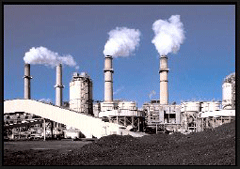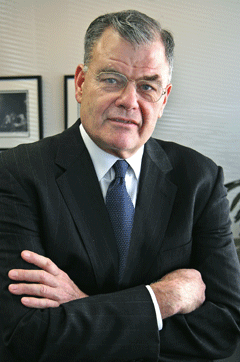Energy up in Smoke
Air Date: Week of February 1, 2008

Heat from smokestacks like these can be recycled to create electricity without burning additional fossil fuels. (Courtesy of the EPA)
Enough wasted heat energy escapes from industrial smokestacks each year to replace 120 coal plants. Thomas Casten, chairman of Recycled Energy Development, explains to host Bruce Gellerman that the only thing stopping recycled heat technology from taking off is outdated federal and state laws.
Transcript
GELLERMAN: Even in post-industrial America, smokestacks still define our landscape. There are half a million smokestacks in the U.S., and nearly 48,000 emit heat above 500 degrees Fahrenheit. To Tom Casten that’s energy literally going up in smoke. His company RED sees a lot of green in capturing it. Casten is chairman of the Illinois-based company Recycled Energy Development – RED. RED buys industrial power plants, recaptures waste heat and then sells the power back to the original company at a discount. Now RED wants to expand and sell excess power back to the grid.
Thomas Casten joins me from the studios of WBEZ in Chicago. Hello Mr. Casten!
CASTEN: Hello Bruce, thanks for having me.
GELLERMAN: You’re very welcome. So, how much energy is going up in smokestacks?
CASTEN: We have an EPA study that says we could make 20 percent of all U.S. electricity by simply capturing the energy that industry wastes using proven technology. Probably could get to 30 percent with some slight new development of technology.
GELLERMAN: So, 20 percent savings. How many nuclear power plants would that be?
CASTEN: About 65 nuclear stations, which is half the U.S. fleet, could be eliminated. You wouldn’t eliminate them, you’d, instead you’d eliminate something like 120 coal plants.

Thomas Casten is chairman of the Illinois-based company Recycled Energy Development (Courtesy of Recycled Energy Development)
CASTEN: Bruce, the technology is very old and it’s the same technology that the power plants use. We basically use the heat to boil water and make steam, we use the steam to drive a turbine, which is the same thing that every nuclear, coal or gas plant does, and the turbine drives an electric generator. The only difference is they burn fuel and release emissions and we don’t. The plants that we build don’t use any fossil fuel. They simply recycle the waste energy out of these stacks you’ve described or other forms of waste energy, and greatly improve the energy productivity.
GELLERMAN: So what’s new with RED?
CASTEN: We are reaching a point where the options for new power are suddenly very much more expensive. What we’ve had happen - coal has tripled in price, gas has quadrupled in price, and all of the new options for power are up in the ten cents a kilowatt hour range. And our projects make sense at five to six cents a kilowatt hour so we’re entering an era where, if the regulators and the politicians will just give clean energy a chance, climate change mitigation will turn into a big economic opportunity.
GELLERMAN: Okay, so, what am I missing?
CASTEN: Meaning it’s too good to be true?
GELLERMAN: Right.

Heat from smokestacks like these can be recycled to create electricity without burning additional fossil fuels. (Courtesy of the EPA)
GELLERMAN: So what one rule, on the federal level, would you like to see change?
CASTEN: The federal Clean Air Act makes improving energy productivity effectively illegal. Once you have a permit for a plant, if you modify it to make it better you lose your permit and you have to go back in and get a new permit based on the latest possible technology. And this has frozen the efficiency of all of our heat and power plants since 1976. It is a disastrous rule. We make energy productivity illegal in the largest industry in the country.
GELLERMAN: So you don’t want to scuttle the Clean Air Act.
CASTEN: Oh, I’m an environmentalist who tries to make my living as a capitalist. I want to have those rules be as cost effective and as environmentally effective as possible. My larger comment is that global warming is such a huge problem; it’s hard to believe we’re going to solve it if our only answer is that people must make sacrifices. We’re offering an approach that profitably reduces greenhouse gases and that’s much easier to persuade people to do - to go improve their own economic lot and do good. We just need to be a little smarter about how we’re doing these things.
GELLERMAN: So if you could change one state rule - you’re in Illinois - what would it be?
CASTEN: Each state gives monopoly protection to the distribution and often the generation of electricity. So this giant industry is not subject to competition like everybody else. What is the most important question in energy? Why has electric generation not improved since Eisenhower? And I believe it hasn’t improved for two reasons: number one, it’s protected from competition by each state; and number two, the federal approach to clean air makes improving efficiency illegal. That’s bad news. But the good news is, those rules were made by human beings. They can be changed. So we change the rules, and we’ll have a little economic boom on our hands.
GELLERMAN: How big can this get?
CASTEN: We’ve estimated that there could be 350 billion dollars spent in the United States on new, efficient, local power plants that recycle energy, and that that would reduce U.S. energy costs by about 70 billion dollars per year, and it would slash total U.S. greenhouse gas emissions by 20 percent for the whole country. It would put the U.S. below the Kyoto level and we’d save 70 billion dollars. So this has the possibility of solving many of America’s problems, not just the environmental problem, but defending against foreign energy supplies and keeping jobs here. One of the things that happens when you do this is that the manufacturer gets an extra revenue stream and cuts its costs. I’m just not willing to say ‘well, the Chinese have lower standards and cheap labor and so they’re going to do all the manufacturing and we’re all going to be Wal-Mart greeters.’ We have brains and a terrific entrepreneurial system and this is a way to apply those brains and return our manufacturers to competitiveness
GELLERMAN: Well Mr. Casten, thank you very much. Good luck.
CASTEN: Thank you, Bruce.
GELLERMAN: Thomas Casten is chairman of Illinois-based Recycled Energy Development: RED.
Links
Living on Earth wants to hear from you!
Living on Earth
62 Calef Highway, Suite 212
Lee, NH 03861
Telephone: 617-287-4121
E-mail: comments@loe.org
Newsletter [Click here]
Donate to Living on Earth!
Living on Earth is an independent media program and relies entirely on contributions from listeners and institutions supporting public service. Please donate now to preserve an independent environmental voice.
NewsletterLiving on Earth offers a weekly delivery of the show's rundown to your mailbox. Sign up for our newsletter today!
 Sailors For The Sea: Be the change you want to sea.
Sailors For The Sea: Be the change you want to sea.
 The Grantham Foundation for the Protection of the Environment: Committed to protecting and improving the health of the global environment.
The Grantham Foundation for the Protection of the Environment: Committed to protecting and improving the health of the global environment.
 Contribute to Living on Earth and receive, as our gift to you, an archival print of one of Mark Seth Lender's extraordinary wildlife photographs. Follow the link to see Mark's current collection of photographs.
Contribute to Living on Earth and receive, as our gift to you, an archival print of one of Mark Seth Lender's extraordinary wildlife photographs. Follow the link to see Mark's current collection of photographs.
 Buy a signed copy of Mark Seth Lender's book Smeagull the Seagull & support Living on Earth
Buy a signed copy of Mark Seth Lender's book Smeagull the Seagull & support Living on Earth

